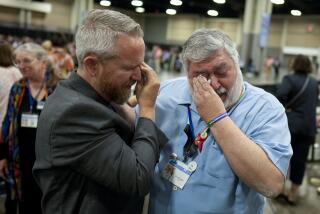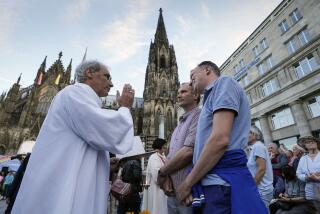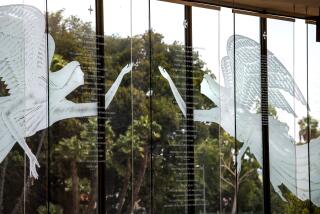Lutherans, Episcopalians Celebrate Pact
- Share via
Two San Gabriel Valley congregations from different mainstream Protestant denominations marked the eve of the new millennium Sunday by commemorating the launch of a new common era.
The congregations, representing the Episcopal Church and the Evangelical Lutheran Church in America, celebrated an agreement that has been 30 years in the making, known as “Called to Common Mission.” It will allow them to recognize one another’s members, pastors and sacraments.
Congregants ushered in the new era with joint services, bridged by a parade between St. Edmund’s Episcopal Church in San Marino and Trinity Evangelical Lutheran Church, three blocks away in San Gabriel.
The same agreement will be celebrated nationally by church officials in Washington next week.
Approved by Lutheran leaders in 1999 and by Episcopal leaders last summer, the agreement forges an alliance that recognizes that both denominations have more in common than not. Both emerged in the 16th century Reformation with a shared basic theology but different traditions, rooted in Lutheran origins in Germany and Episcopal origins in England.
Lutherans and Episcopalians in Orange County held the same kind of united church services. “I never thought I would see this happen,” the Rt. Rev. J. Jon Bruno, bishop coadjutor of the Los Angeles Episcopal Diocese, said at Redeemer Evangelical Lutheran Church in the Leisure World Retirement Community.
Bruno and Bishop Murray Finck of the Lutheran Church’s Yorba Linda-based Pacifica Synod each signed the agreement during Sunday morning’s special services in Orange County. When they were done, the men hugged, the congregations applauded and Bruno announced: “I think we made history!”
In San Marino, during the first part of the service at St. Edmund’s, Bishop Paul Egertson of the Glendale-based Southern California West Synod of the Lutheran Church joked about one of the denominations’ remaining differences: the Episcopal belief that bishops are part of an unbroken line of succession from the apostles of Jesus Christ, contrasted with a less lofty Lutheran view.
Recalling his own installation as bishop on Super Bowl Sunday 1995, he said: “Lutherans install bishops rather than . . . coronate them. . . . As I remarked at my installation, you coronate kings. You install appliances.”
When it was his turn, the Rt. Rev. Frederick H. Borsch, bishop of the six-county Episcopal Diocese of Los Angeles, also joked. Looking over the standing-room-only crowd, he gave thanks to Trinity choir members for wearing red. Otherwise, he said: “It’s very difficult to tell who’s a Lutheran and who’s an Episcopalian.”
In a sermon, he cited the observations of a theologian that different denominations sometimes were shaped by social and ethnic needs. Then, he said, they had “to establish theological differences to explain the differences between them.”
The unity agreement between the largest American Lutheran church, with a membership of 5.2 million, and 2.4 million Episcopalians allows both churches to maintain their own traditions and methods of governance, he said.
“But at a deeper level, we have come together today to establish that we are one church. . . . This is the one word of God that has been given to us.”
The service was interrupted by the march to nearby Trinity, as hundreds of members of both churches walked down San Gabriel Boulevard, stopping traffic briefly as they crossed busy Huntington Drive and turning heads as some of them whooped it up with horns, tambourines and other noisemakers.
At Trinity, clergy from both denominations gave Communion.
Commentators see the agreement as a boost for ecumenism. It may be largely symbolic in well-heeled churches. But in some rural and urban areas, with small, poor congregations, it will allow Episcopal and Lutheran churches to save money by sharing pastors.
Lutherans have been at the center of the ecumenical movement. They have forged similar agreements with the Presbyterian Church in the United States, the United Church of Christ and the Reformed Church in America.
*
Times staff writer Kimi Yoshino contributed to this story.
More to Read
Sign up for Essential California
The most important California stories and recommendations in your inbox every morning.
You may occasionally receive promotional content from the Los Angeles Times.













